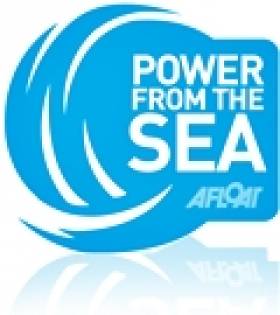Displaying items by tag: hydrokinetic energy
Connemara Company Secures €3m from EU to Design Marine Turbine from Recycled Materials
A Connemara company has secured €3 million from the European Commission to research and design a marine turbine that uses recycled materials for the first time.
As The Times Ireland edition reports, designers at ÉireComposites in Indreabhán, Co Galway, believe their marine hydrokinetic power system can produce clean energy reliably at a reduced cost.
It will work with partners including marine renewable energy specialists Ocean Renewable Power Company (ORPC), NUI Galway, Mitsubishi Chemical Advanced Materials in Germany and Consiglio Nazionale delle Ricerche, the Italian state research company.
 A graphic of the RivGen device deployed
A graphic of the RivGen device deployed
Total value of the project is €3.9m, of which some €3m has been awarded to the Irish design team.
 RivGen Power System in 2019 at Igiugig, Alaska
RivGen Power System in 2019 at Igiugig, Alaska
Tomás Flanagan, chief executive officer at ÉireComposites, said the aim is to use recycled carbon fibre for a “mini” version of a larger turbine that ORPC will build.
 The RivGen device operating in the Alaskan Kvichak River in April 2020
The RivGen device operating in the Alaskan Kvichak River in April 2020
He says that marine turbine systems can harvest a potential 615 terawatt-hours per year from tidal streams, ocean currents and river currents – as in approximately 21 times Ireland’s annual electricity use.
Named “Crimson”, as in “Commercialisation of a Recyclable and Innovative Manufacturing Solution for an Optimised Novel”, the turbine project is being supported by the European Commission’s Horizon 2020 Fast Track to Innovation programme.
 An aerial view of the RivGen device operating in the Kvichak River, in Alaska in August 2019
An aerial view of the RivGen device operating in the Kvichak River, in Alaska in August 2019
ÉireComposites has already worked with ORPC, which has headquarters in Portland, Maine, USA and a base in Ireland, on previous turbine design projects.
These include ORPC’s first commercial river generation power system, installed in Igiugig, Alaska, to provide a remote community with local energy from the Kvichak river.
The Connemara company is one of 16 partners in seven countries in the EU-funded Marewind project to design the next generation of offshore wind turbines.
It also recently secured a contract to design and manufacture equipment for the European Space Agency’s Altius satellite, which is due to be launched from French Guiana in 2023
Read The Times Ireland here
€3.6 million to Irish Wave Ocean Firm
Energy Minister Eamon Ryan announced today that Irish company Wavebob Ltd has secured a grant of $2.4 million (€1.83 million) from the US Department of Energy to prepare for a commercial-scale wave energy demonstration project planned for US waters in 2013.
Minister Ryan also announced that Bord Gáis is to invest €1.8m in Wavebob Ltd, bringing the total investments to €3.6 million .
The Minister said, "The Irish Government is committed to the development and commercialisation of ocean energy. Wavebob is an innovative Irish company that is thriving even in this tough economic climate, securing one investment after another from major energy utilities at home and abroad.
The recognition of Wavebob's potential by the US Department of Energy also goes to show that as the effects of climate change become increasingly evident, the exploitation of new, clean energy sources is becoming more and more urgent. The Irish Government will continue our absolute commitment to the emergent ocean energy sector and to encouraging the work of world-class companies such as Wavebob.
Renewable energy is the way forward for Ireland. We can use our own homegrown energy and create the new Irish jobs. I wish Wavebob well in their venture"
The grant forms part of $37m in marine and hydrokinetic energy grants announced by the US Department. It will be used to further develop Wavebob Ltd.'s wave energy converter (WEC), which is currently in pre-commercial development. At full scale, the device is capable of producing in excess of one megawatt of energy with average output of over 500kW at sites in the North Atlantic and Pacific oceans.
The 'Wavebob' was one of the first WEC's in the world to successfully produce electricity from ocean swell in 2007. The US Department of Energy grant will be used specifically to develop and test their advanced power take-off device. The project benefits from support and collaboration with Vattenfall, one of Europe's largest utility companies, and Chevron and Lockheed Martin in the US.
"The Department of Energy's funding program for marine hydrokinetic technologies is vital to the development of both products and markets, at home and abroad. We are honoured to be selected for this award through a highly competitive process, and to be working with a distinguished team of leaders in maritime technology", said Derek Robertson, President of Wavebob's US operations based in Annapolis, Maryland.
Traditional sources of finance for technology development have become more and more scarce as a result of the global economic crisis, with the result that many Irish companies are struggling to survive. On the bright side however, Andrew Parish, C.E.O. of Wavebob Ltd., feels that the Irish energy utilities are making particularly good use of state assets in recognizing the world-class potential of a small Irish indigenous company such as Wavebob Ltd. "This investment from Bord Gáis builds on a previous technical agreement with ESBI and clearly demonstrates that Irish utilities recognize the ocean energy opportunity and are key agents of Government policy in maximizing the potential to Ireland of this immense natural resource", he said.
John Mullins, CEO of Bord Gais, says that Ireland has one of the best wave resources off its west coast, "It is important that utilities such as Bord Gais foster the development of companies like Wavebob, to enable them to advance their technology. Bord Gais will be actively involved in this development and we will commit our own resources to its advancement", " he said.






























































